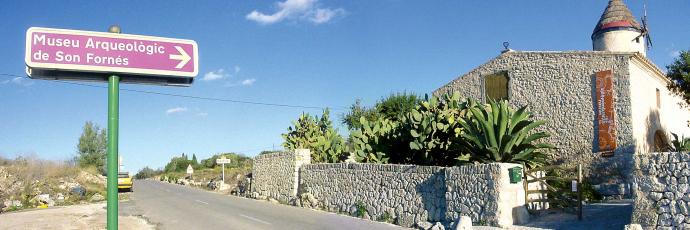Montuïri:
TALAIOT SON FORNÉS
I have enjoyed visiting Son Fornés many times. The site is close to the little town of Montuiri and is one of the most important and best preserved Talaiotic settlements in Mallorca. Its origin is dated to the main phase of the Talaioticum, around 900 BC. From 550 B.C. to around 250 B.C., a new construction phase was added, which incorporated existing building masses from earlier times into the construction. Even during the historical period when Mallorca was under Punic and Roman rule, construction continued on Son Fornés. It was only shortly before the fall of the Western Roman Empire, towards the end of the fifth century of our time, that signs of settlement at the site disappear. 
| | | |
| | 
| | |
| | 
| 
| |

| 
| 
| 
|
Talaiot number one is 17 metres in diameter and 3.5 metres high. Its five-metre-thick wall consists of two circular walls, the space between them filled with stones and earth. The individual stone blocks weigh up to nine tonnes. A five-metre-long, low corridor leads inside. Here, remains of hinges have been found, suggesting closure by a wooden door. Inside, there is the preserved central column that supported the roof, two fireplaces, a low semicircular wall and a small chamber let into the wall, the purpose of which is still unclear (my guess is a refrigerator). This talaiot presumably served as a storehouse, because it was found filled with the remains of slaughtered cattle, goats and pigs.
Talaiot number two is much smaller than the first but special among all the known talaiots in Mallorca. It did not have the usual entrance corridor. To enter this talaiot, one had to climb onto the roof from the outside, presumably with a ladder, and could then comfortably go down on a spiral staircase made of stone set into the wall on the inside. The ceramics found here also differ so clearly from the simple utilitarian ceramics of the time that it is assumed that this talaiot was a special meeting place. Probably only a small elite circle of people came together here, perhaps priests and/or the leaders of the village, to hold ritual or political meetings.
Excavations
In various excavation campaigns, which usually take place during the semester break in summer, further parts of Son Fornés have been uncovered in recent years. Archaeologists and helpers from all over Europe come to Montuïri for this purpose.
So far only a small part of the Talaiotic settlement has been uncovered. Space enough for around 400 to 500 people who may have lived here in Talaiotic times. However, as most of the site is still underground, future excavations may well be full of surprises.
Montuiri Archaeological Museum
The fact that comparatively much is known about Son Fornés, despite the lack of lore, is thanks to a small museum in Montuiri that deals exclusively with this site. Archaeologists from the University of Barcelona work here and have been carrying out scientific excavations on the site since 1975. The findings are used to reconstruct and document life in Son Fornés during its 1,500 years of settlement. The most important and interesting finds then end up here in a beautiful exhibition.
I recommend starting a visit to Son Fornés at the museum. With the appropriate background knowledge, the walk through the excavation site becomes a much deeper experience.
I heard that work has started on the renovation of the old finca on the excavation site. After completion, the museum will move there. So if you want to visit the museum, then find out whether it is still in the old mill at the roundabout in Montuiri, or already in its new home, right next to the excavation.





















